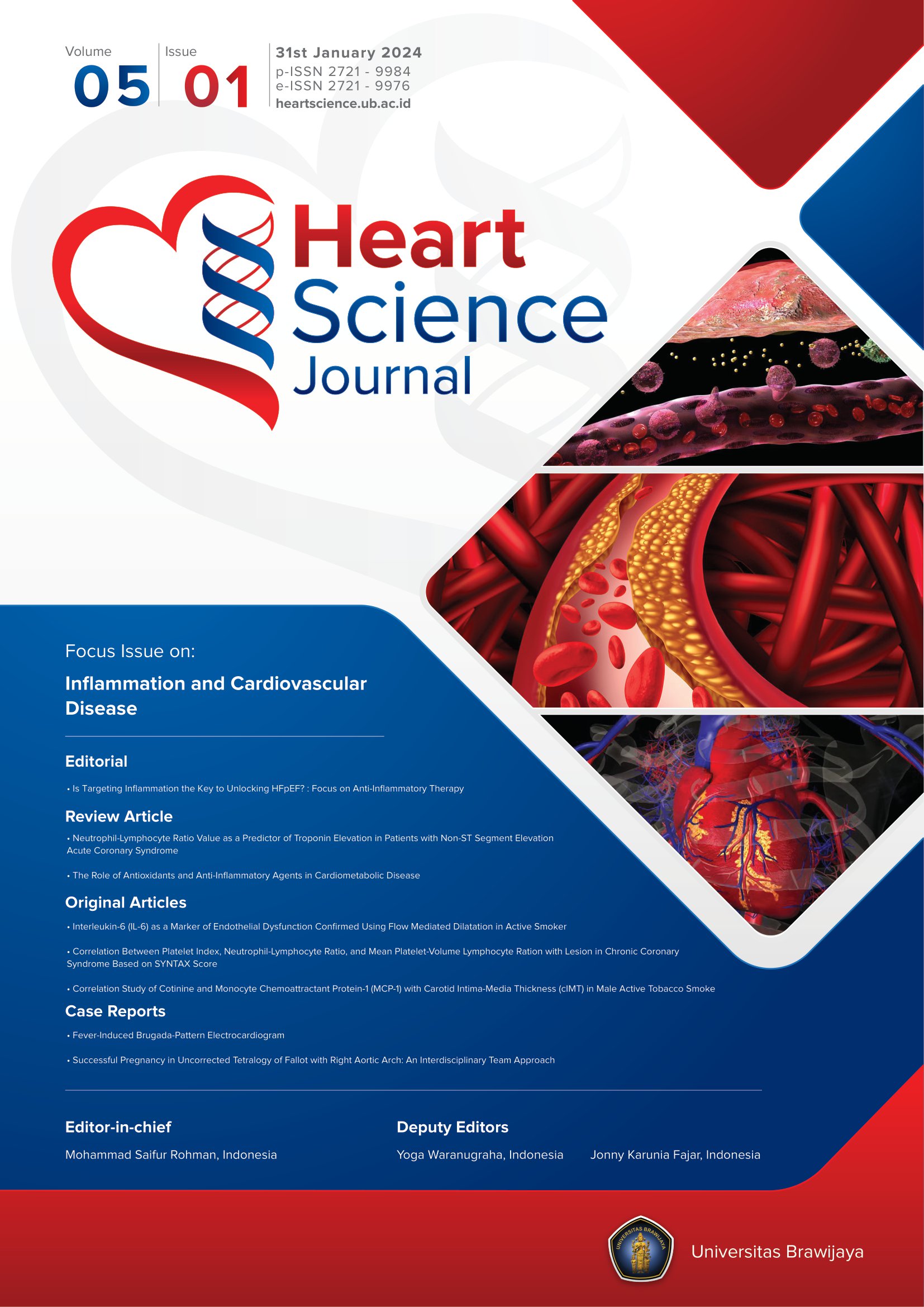The Role of Garcinia Mangostana Pericarp Extract as Antioxidant to Inhibit Atherosclerosis Process in High Risk Framingham Score Patient; Original Article
Abstract
Atherosclerosis is the pivotal role of cardiovascular disease (CVD) involving oxidative stress dan inflammation. Garcinia has anti-oxidant property for years. This study was performed to explore the role of α-Mangostin of Garcia Mangostana Pericarp Extract as an antioxidant in inhibiting atherosclerotic process in patients with high-risk Framingham score.
Methods: This prospective cohort design was led in 90 grown-ups with high hazard cardiovascular score which were resolved dependent on Framingham criteria, age 50–70 years of age. The patients were divided into two groups. One group was administered 2520 mg/day Garcinia mangostana Linn extracts (GMLE) in 3 divided doses for 90 days and the other group was administered a placebo. Parameters were Nitric Oxide (NO), Superoxide Dismutase (SOD) and Malondialdehyde (MDA), measured at baseline and after 90 days of treatment. An Independent T-test was performed for normally distributed data and the Mann-Whitney test was performed for abnormally distributed data with a significance level of p≤0.05.
Results: Among the 77 subjects, we found that the plasma, MDA, concentration was significantly decreased compared with placebo 0,29±0.5 vs -0.04±0.25, respectively p = 0.011). SOD level significantly decreased in GMLE patients compared with placebo patients (0,17±0.79 vs -0.27±0.67, respectively, p=0.010) and we found that there was slightly increased in nitric oxide (NO), but no significantly compared with placebo 4.34±10.01 and 2.35±7.39, respectively, p = 0.37).
Conclusion: Garcinia mangostana pericarp extract has an antioxidant effect that significantly inhibit atherosclerosis process in high-risk Framingham score patients
Full Text:
PDFReferences
Sanchis-Gomar F, Perez-Quilis C, Leischik R, et al. Epidemiology of coronary heart disease and acute coronary syndrome. Ann Transl Med. 2016 Jul; 4(13): 256
Benjamin EJ, Blaha MJ, Chiuve SE, Cushman M, et al. Heart disease and stroke statistics-2017 update: a report from the American Heart Association. Circulation. doi: 10.1161/CIR.0000000000000485.
WHO. Cardiovascular diseases (CVDs). 2017. www.who.int/mediacentre/factsheets/fs317/en/
Bentzon JF, Otsuka F, Virmani R, Falk E. Mechanisms of Plaque Formation and Rupture. Circ Res. 2014; 114: 1852-1866.
Yang RL, Shi YH, Hao G, et al. Increasing Oxidative Stress with Progressive Hyperlipidemia in Human: Relation between Malondialdehyde and Atherogenic Index. J. Clin. Biochem. Nutr. 2008; 43: 154-158.
Fukai T, Ushio-Fukai M. Superoxide Dismutases: Role in Redox Signaling, Vascular Function, and Diseases. Antioxid. Redox Signal. 2011. 15(6): 1583-1606.
Davignon J, Ganz P. Role of Endothelial Dysfunction in Atherosclerosis. Circulation. 2004; 109: III-27-III-32.
Boos CJ, Lip GYH, Blann AD. Circulating Endothelial Cells in Cardiovascular Disease. J Am Coll Cardiol 2006; 48: 1538-47.
Jung HA, Su BN, Keller WJ, et al. Antioxidant Xanthones from the Pericarp of Garcinia mangostana (Mangosteen). J. Agric. Food Chem. 2006, 54, 2077-2082.
Adiputro DL, Khotimah H, Widodo MA, Romdoni R, Sargowo D. Effects of ethanolic extracts of Garcinia mangostana fruit pericarp on oxidant-antioxidant status and foam cells in atherosclerotic rats. Oxid Antioxid Med Sci 2013; 2(1): 61-61.
Priya V, Jainu M, Mohan SK, et al. Toxicity Study of Garcinia mangostana Linn. Pericarp Extract in Rats. Asian J. Exp. Biol. Sci. Vol 1(3) 2010 :633-637.
Di Pietro N., Formoso G., Pandolfi A. 2016. Physiology and Pathophysiology of OxLDL Uptake by Vascular Wall Cells in Atherosclerosis. Vascular Pharmacology; 84: 1-7.
Vohra RS, Murphy JE, Walker JH, et al, 2006, TheLOX-1 scavenger receptor and atherosclerotic plaque rupture, FASEB J. 21: 743-7
Pedraza J, Noemi C, 2008, Medical Properties of Mangosteen in Food and Chemical Toxicology, 46: 3227-3239
Candas D. & Li J. J. 2014. MnSOD in Oxidative Stress Response-Potential Regulation via Mitochondrial Protein Influx. Antioxidants & Redox Signaling; 20(10): 1599-1617.
Wang A., Liu Q., Ye Y., Wang Y., Lin L. 2015. Identification of Hepatoprotective Xanthones from the Pericarps of Garcinia mangostana, Guided with tert-butyl Hydroperoxide Induced Oxidative Injury in HL-7702 Cells. Food & Function; 6(9): 3013-3021.
Arkhaesi, Nahwa. Kadar Malondialdehyde (MDA) Serum Sebagai Indikator Prognosis Keluaran pada Sepsis Neonatorum. Tesis. Program Pascasarjana Magister Ilmu Biomedik dan Program Pendidikan Dokter Spesialis-1 Ilmu Kesehatan Anak Univesitas Diponegoro, Semarang. 2008.
Winarsi, Henry, Antioksidan Alami & Radikal Bebas, Kanisius. 2007, Yogyakarta
Kondo M, Zhang L, Ji H,et al. 2009. Bioavailability and Antioxidant Effects of a Xanthone-Rich Mangosteen (Garcinia mangostana) Product in Humans. Journal of Agriculture and Food chemistry. 2009,57,8788-8792
Chen J., Ye Z., Wang X., Chang J., Yang M., Zhong H., Hong F., Yang S. 2018. Nitric Oxide Bioavailability Dysfunction Involves in Atherosclerosis. Biomedicine & Pharmacotherapy; 97: 423-428.
Jiang D. J., Hu G. Y., Jiang J. L., Xiang H. L., Deng H. W., Li Y. J. 2003. Relationship Between Protective Effect of Xanthone on Endothelial Cells and Endogenous Nitric Oxide Synthase Inhibitors. Bioorganic & Medicinal Chemistry; 11(23): 5171-5177.
DOI: https://doi.org/10.21776/ub.hsj.2021.002.01.04
Refbacks
- There are currently no refbacks.
Copyright (c) 2021 Heart Science Journal

This work is licensed under a Creative Commons Attribution 4.0 International License.









